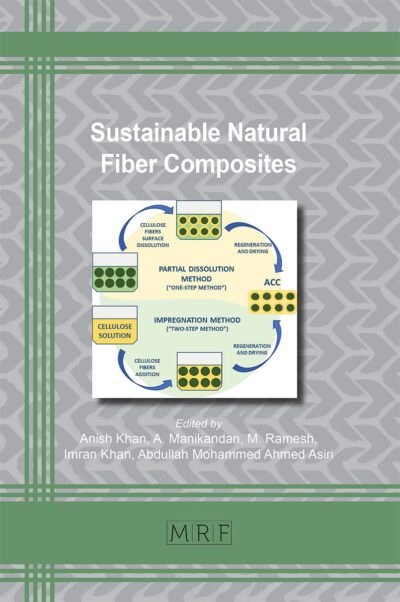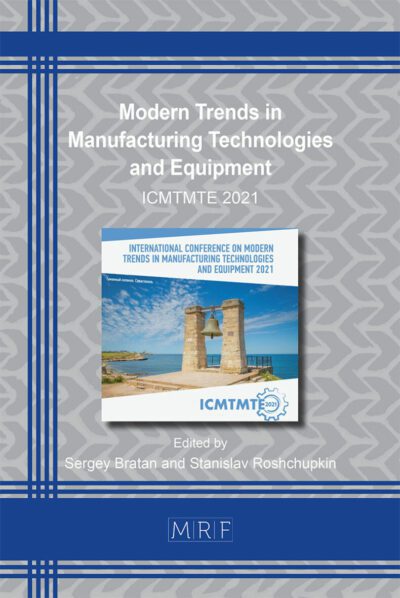An Inverse method for determining fabric permeability in vacuum assisted resin infusion for composite parts forming
VOSNIAKOS George-Christopher, DIMAKOPOULOS Panagiotis J., VASILEIOU Anastasia
download PDFAbstract. Vacuum Assisted Resin Infusion (VARI) method employs a mould on top of which a number of fabric pieces are laid up and impregnated by resin drawn through vacuum. Simulation of VARI depends on the determination of fabric permeability. In this work, permeability value is selected from a set of discrete values by a genetic algorithm. An impregnation simulation model is run on ComsolTM to compute the flow front propagation inside the fabric. The genetic algorithm compares the evolution (propagation) of the impregnation front, in a space and time dimension, with the corresponding result of one single actual impregnation experiment, obtained by machine vision. A simple part suffices for this experiment assuming homogenous fabric porosity. The computational cost of the method is low, making it superior to experimental determination of permeability on expensive custom-made devices.
Keywords
Composite Materials, Resin Infusion, Permeability, Genetic Algorithms
Published online 4/19/2023, 10 pages
Copyright © 2023 by the author(s)
Published under license by Materials Research Forum LLC., Millersville PA, USA
Citation: VOSNIAKOS George-Christopher, DIMAKOPOULOS Panagiotis J., VASILEIOU Anastasia, An Inverse method for determining fabric permeability in vacuum assisted resin infusion for composite parts forming, Materials Research Proceedings, Vol. 28, pp 407-416, 2023
DOI: https://doi.org/10.21741/9781644902479-45
The article was published as article 45 of the book Material Forming
![]() Content from this work may be used under the terms of the Creative Commons Attribution 3.0 license. Any further distribution of this work must maintain attribution to the author(s) and the title of the work, journal citation and DOI.
Content from this work may be used under the terms of the Creative Commons Attribution 3.0 license. Any further distribution of this work must maintain attribution to the author(s) and the title of the work, journal citation and DOI.
References
[1] A. Hindersmann, Confusion about infusion: An overview of infusion processes, Compos. Part A: Appl. Sci. Manuf. 126 (2019) 105583. https://doi.org/10.1016/j.compositesa.2019.105583
[2] C. Di Fratta, F. Klunker, P. Ermanni, Innovative approach to track flow front in LCM processes through pressure sensors in line quality control, 11th Intern. Conf. on Flow Processing in Composite Materials (FPCM 11), 2012, pp. 204-211.
[3] N. Vernet, E. Ruiz, S. Advani, J.B. Alms, M. Aubert, M. Barburski, B. Barari, J.M. Beraud, D.C. Berg, N. Correia, M. Danzi, T. Delaviere, M. Dickert, C. Di Fratta, A. Endruweit, P. Ermanni, G. Francucci, J.A. Gracia, A. George, C. Hahn, F. Klunker, S.V. Lomov, A. Long, B. Louis, J. Maldonado, R. Meier, V. Michaud, H. Perrin, K. Pillai, E. Rodriguez, F. Trochu, S. Verheyden, M. Wietgrefe, W. Xiong, S. Zaremba, G. Ziegmann, Experimental determination of the permeability of engineering textiles: Benchmark II, Compos. Part A: Appl. Sci. Manuf. 61 (2014) 172-184. https://doi.org/10.1016/j.compositesa.2014.02.010
[4] P. Carlone, G.S. Palazzo, Unsaturated and saturated flow front tracking in liquid composite molding processes using dielectric sensors, Appl. Compos. Mater. 22 (2015) 543-557. https://doi.org/10.1007/s10443-014-9422-3
[5] V. Antonucci, M. Esposito, M.R. Ricciardi, M. Raffone, M. Zarrelli, M. Giordano, Permeability characterization of stitched carbon fiber preforms by fiber optic sensors, Express Polym. Lett. 5 (2011) 1075–1084. https://doi.org/10.3144/expresspolymlett.2011.105
[6] S. Konstantopoulos, C. Hueber, E. Mühlbachler, R. Schledjewski, Identification of the effect of typical curvatures encountered in RTM parts on localized permeability of fibrous preforms, Adv. Manuf. Polym. Compos. Sci. 2 (2016) 57-66. https://doi.org/10.1080/20550340.2016.1229829
[7] H. Golestanian, M. Poursina, Neural Network Analysis Application To Permeability Determination of Fiberglass and Carbon Preforms, Chinese J. Polym. Sci. 27 (2009) 22-229.
[8] F. Klunker, S. Aranda, W. Surjoseputro, W. Wu, G. Ziegmann, C. Elsenhans, H. Behnke, Modelling the resin infusion process, Part I: Flow modelling and numerical investigation for constant geometries, Zeitschrift Kunststofftechnik/J. Plast. Technol. 7 (2011) 178-201.
[9] B. Verleye, S. Lomov, A. Long, D. Roose, C.C. Wong, Permeability of Textile Reinforcements : Efficient Prediction and Validation, Polymer. (2007) 2-3.
[10] X. Zeng, A. Endruweit, L.P. Brown, A.C. Long, Numerical prediction of in-plane permeability for multilayer woven fabrics with manufacture-induced deformation, Compos. Part A Appl. Sci. Manuf. 77 (2015) 266–274. https://doi.org/10.1016/j.compositesa.2015.03.027
[11] J.P. Dunkers, F.R. Phelan, C.G. Zimba, K.M. Flynn, D.P. Sanders, R.C. Peterson, R.S. Parnas, X. Li, J.G. Fujimoto, The prediction of permeability for an epoxy/E-glass composite using optical coherence tomographic images, Polym. Compos. 22 (2001) 803-814. https://doi.org/10.1002/pc.10582
[12] M. Griebel, M. Klitz, Homogenization and Numerical Simulation of Flow in Geometries with Textile Microstructures, SIAM Multiscale Model. Simul. 8 (2010) 1439-1460. https://dx.doi.org/10.1137/09077059X
[13] F. Zhang, B. Cosson, S. Comas-Cardona, C. Binetruy, Efficient stochastic simulation approach for RTM process with random fibrous permeability, Compos. Sci. Technol. 71 (2011) 1478-1485. https://doi.org/10.1016/j.compscitech.2011.06.006
[14] G. Morren, H. Sol, B. Verleye, S.V. Lomov, Permeability Identification of a Reference Specimen Using an Inverse Method, 2007 SEM Annu. Conf. Expo., 2007, 8.
[15] P. Carlone, F. Rubino, V. Paradiso, F. Tucci, Multi-scale modeling and online monitoring of resin flow through dual-scale textiles in liquid composite molding processes, Int J. Adv. Manuf. Techn. 96 (2018) 2215-2230. https://doi.org/10.1007/s00170-018-1703-9
[16] P. Boisse, R. Akkerman, P. Carlone, L. Kärger, S.V. Lomov, J.A. Sherwood, Advances in composite forming through 25 years of ESAFORM. Int. J. Mater. Form. 15 (2022) 1-30. https://doi.org/10.1007/s12289-022-01682-8
[17] A.N. Vasileiou, G.-C. Vosniakos, D.I. Pantelis, Determination of local heat transfer coefficients in precision castings by genetic optimisation aided by numerical simulation, Proc. Inst. Mech. Eng., Part C: J. Mech. Eng. Sci. 229 (2015) 735-750. https://doi.org/10.1177/0954406214539468
[18] L. Joubaud, F. Trochu, J. Le Corvec, Analysis of resin flow under flexible cover in Vacuum Assisted Resin Infusion (VARI), J. Adv. Mater. 37 (2005) 3-10.
[19] P. Mitschang, M. Glawe, D. Kreutz, G. Rieber, D. Becker, Influence of textile parameters on the through-the-thickness permeability of woven textiles, Proc. 11th Intern. Conf. on Flow Processing in Composite Materials (FPCM 11), 2012, 37-45.














